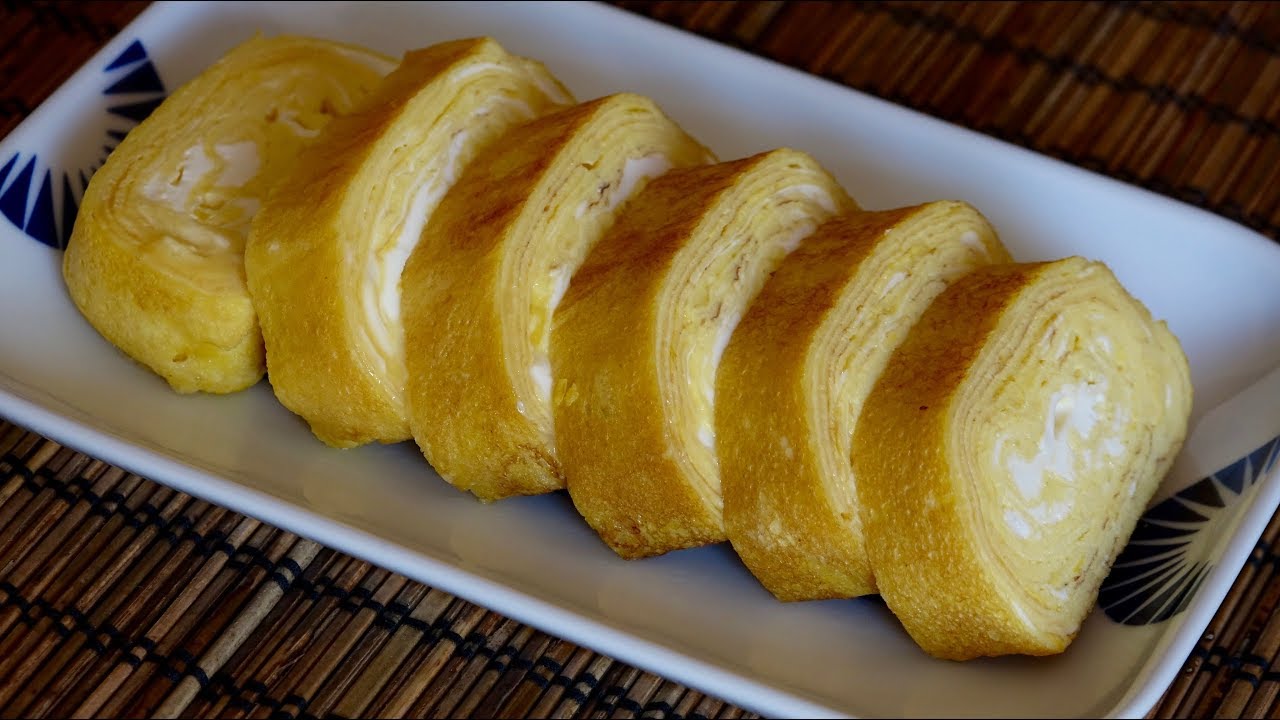Tamago, or Japanese rolled omelette, is a delightful and slightly sweet dish often enjoyed in sushi or as a standalone treat. This recipe offers a perfect balance of flavors with a hint of sweetness from the sugar and mirin, and a touch of umami from the soy sauce. It's a versatile dish that can be enjoyed for breakfast, lunch, or dinner.
Some ingredients in this recipe might not be commonly found in every household. Mirin is a sweet rice wine used in Japanese cooking, and soy sauce adds a savory depth. Both can be found in the Asian section of most supermarkets. If you don't have a tamagoyaki pan, a small non-stick skillet will work just fine.

Ingredients for Japanese Tamago Egg Recipe
Eggs: The base of the dish, providing protein and structure.
Sugar: Adds sweetness to balance the savory elements.
Mirin: A sweet rice wine that enhances the flavor.
Soy sauce: Adds umami and depth to the dish.
Salt: Enhances the overall flavor.
Vegetable oil: Used for cooking to prevent sticking.
Technique Tip for This Recipe
When making tamago, it's crucial to control the heat of your pan. Too high a temperature can cause the egg mixture to cook too quickly, resulting in a dry and overcooked omelette. Aim for a medium-low heat to ensure the eggs cook gently and evenly, allowing you to achieve that perfect, slightly sweet and tender texture.
Suggested Side Dishes
Alternative Ingredients
eggs - Substitute with tofu: Use silken tofu blended with a pinch of turmeric for color. This provides a similar texture and appearance for a vegan alternative.
sugar - Substitute with honey: Honey adds a similar sweetness and can be used in the same quantity, though it may slightly alter the flavor profile.
mirin - Substitute with rice vinegar and sugar: Mix 1 tablespoon of rice vinegar with ½ teaspoon of sugar to mimic the sweetness and acidity of mirin.
soy sauce - Substitute with tamari: Tamari is a gluten-free alternative to soy sauce and has a similar umami flavor.
salt - Substitute with sea salt: Sea salt can be used in the same quantity and provides a similar level of seasoning.
vegetable oil - Substitute with canola oil: Canola oil has a neutral flavor and similar cooking properties, making it a suitable replacement.
Other Alternative Recipes Similar to This Dish
How to Store or Freeze This Dish
Allow the tamago to cool completely at room temperature before storing. This helps prevent condensation, which can make the omelette soggy.
Wrap the tamago tightly in plastic wrap or aluminum foil to maintain its moisture and prevent it from drying out.
Place the wrapped tamago in an airtight container to further protect it from absorbing any unwanted odors from the refrigerator.
Store the tamago in the refrigerator for up to 3 days. For optimal freshness, consume it within this timeframe.
If you wish to freeze the tamago, first slice it into individual portions. This makes it easier to thaw and reheat only what you need.
Wrap each portion of tamago in plastic wrap, ensuring there are no air pockets. Then, place the wrapped portions in a freezer-safe bag or container.
Label the container with the date to keep track of how long it has been stored. The tamago can be frozen for up to 1 month.
To thaw, transfer the desired portions from the freezer to the refrigerator and let them thaw overnight. Avoid thawing at room temperature to prevent bacterial growth.
Reheat the thawed tamago gently in a non-stick skillet over low heat or in the microwave. If using the microwave, cover the tamago with a damp paper towel to retain moisture.
Enjoy the reheated tamago as part of a bento box, on top of sushi, or as a delightful breakfast treat.
How to Reheat Leftovers
Microwave Method: Place the tamago slices on a microwave-safe plate. Cover them with a damp paper towel to retain moisture. Heat on medium power for 20-30 seconds. Check and add more time if needed, but be careful not to overcook as it can become rubbery.
Stovetop Method: Heat a non-stick skillet over low heat. Add a small amount of vegetable oil or butter. Place the tamago slices in the skillet and cover with a lid. Heat for 1-2 minutes on each side until warmed through. This method helps maintain the texture and flavor.
Steaming Method: Place the tamago slices on a heatproof plate. Set up a steamer or use a pot with a steaming rack and a small amount of water. Steam the tamago for about 3-5 minutes until heated through. This method keeps the tamago moist and tender.
Oven Method: Preheat your oven to 300°F (150°C). Wrap the tamago slices in aluminum foil to prevent drying out. Place them on a baking sheet and heat for about 10 minutes. This method is great for reheating larger batches.
Best Tools for This Recipe
Mixing bowl: A large bowl used to beat the eggs and mix in the sugar, mirin, soy sauce, and salt.
Tamagoyaki pan: A rectangular or square pan specifically designed for making tamagoyaki, allowing for easy rolling of the omelette.
Non-stick skillet: An alternative to the tamagoyaki pan, used to cook the egg mixture without sticking.
Chopsticks: Traditional Japanese utensils used to roll the egg layers in the pan.
Spatula: A flat tool used to help roll the egg if chopsticks are difficult to use.
Measuring spoons: Tools used to measure out the sugar, mirin, soy sauce, and salt accurately.
Vegetable oil: Used to lightly oil the pan to prevent the egg from sticking.
Knife: Used to slice the rolled omelette once it has cooled slightly.
Cutting board: A surface on which to slice the rolled omelette.
How to Save Time on Making This Recipe
Prepare ingredients in advance: Measure and mix sugar, mirin, soy sauce, and salt with the eggs ahead of time.
Use a non-stick pan: A non-stick skillet ensures the egg mixture cooks evenly and rolls easily.
Preheat the pan: Make sure the pan is hot before adding the egg mixture to speed up cooking.
Consistent layers: Pour thin, even layers of the egg mixture to ensure quick and uniform cooking.
Minimal oil: Use just enough vegetable oil to coat the pan, reducing the need for frequent re-oiling.

Japanese Tamago Egg Recipe
Ingredients
Main Ingredients
- 4 eggs
- 2 tablespoon sugar
- 1 tablespoon mirin
- 1 teaspoon soy sauce
- 1 pinch salt
- 1 teaspoon vegetable oil for cooking
Instructions
- 1. In a mixing bowl, beat the eggs and add sugar, mirin, soy sauce, and salt. Mix well.
- 2. Heat the tamagoyaki pan or small non-stick skillet over medium heat and lightly oil it.
- 3. Pour a thin layer of the egg mixture into the pan, tilting to cover the bottom. Cook until the egg is half set.
- 4. Using chopsticks or a spatula, roll the egg towards you. Move the rolled egg to the far side of the pan.
- 5. Add more oil if needed, then pour another thin layer of egg mixture into the pan. Lift the rolled egg to let the uncooked egg flow underneath.
- 6. When the new layer is half set, roll the egg again. Repeat until all the egg mixture is used.
- 7. Remove the rolled omelette from the pan and let it cool slightly before slicing.
Nutritional Value
Keywords
More Amazing Recipes to Try 🙂
- Slow Cooker Chili Recipe8 Hours 15 Minutes
- Summer Squash Bread Recipe1 Hours 15 Minutes
- Apple Cider Recipe40 Minutes
- Watermelon Lemonade Recipe10 Minutes
- Electric Lemonade Recipe10 Minutes
- Turkey Wraps Recipe10 Minutes
- Fresh Banana Daiquiri Recipe10 Minutes
- Cosmopolitan Recipe5 Minutes

Leave a Reply